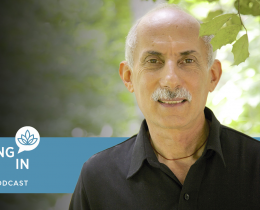To begin this simple but relaxing meditation, select a quiet time and place. You can be seated on a cushion or chair. Take a upright yet relaxed posture, as though with the quiet dignity of a king or queen.
Close your eyes gently and begin by bringing present and loving attention to whatever you feel within you and around you. Let your mind be spacious and your heart be kind and soft.
As you sit, feel the sensations of your body. Notice what sounds and feelings, thoughts and expectations are present. Allow them all to come and go, to rise and fall like the waves of the ocean. Be aware of the waves and rest seated in the midst of them. Allow yourself to become more and more still.
In the center of all these waves, feel your breathing, your life-breath. Let your attention feel the in-and-out breathing wherever you notice it, as a coolness or tingling in the nose or throat, as a rising and falling of your chest or abdomen. Relax and softly rest your attention on each breath, feeling the movement in a steady, easy way. Let the breath find its own rhythm, long or short, soft or deep.
As you feel each breath carefully, relax and settle into its movement. Let this loving attention to breathing gradually quiet your body and mind and soften the heart. Allow all other sounds and sensations, thoughts and feelings continue to come and go like waves of the ocean in the back ground.
After a few breaths, your attention may be carried away by one of the stronger waves of thoughts or memories, or by body sensations or sounds. Whenever you notice you have been carried away for a time, acknowledge the wave of thought or sensation by softly giving it a name such as “planning,” “remembering,” “sadness,” “excitement.” Then let it pass and gently return to the breath.
Some waves will take a long time to pass, others will be short. Certain thoughts or feelings will be painful; others will be pleasurable. Whatever they are, let them be.
Sometimes, you will be able to return to your breath easily, and awareness of your breath will bring steadiness and well-being. At other times during your meditation, you will be mostly aware of body sensation or of plans or thoughts. Either way is fine.No matter what you experience, be aware of it, let it come and go, and rest at ease in the midst of it all.
After you have sat for 20 or 30 minutes in this way, open your eyes and look around before you get up. Then, as you move, try to allow the same spirit of loving awareness you have experienced in meditation to go with you into the activities of your day.
The art of meditation is simple, though not always easy. It thrives on practice and a kind and spacious heart. If you do this simple breath practice of sitting with awareness every day, you will gradually grow in centeredness and understanding.



